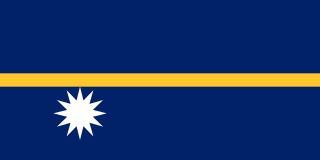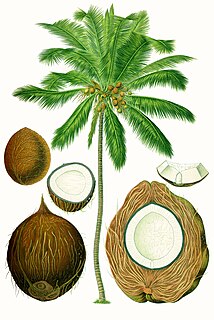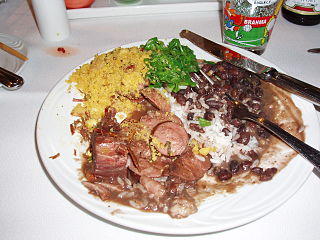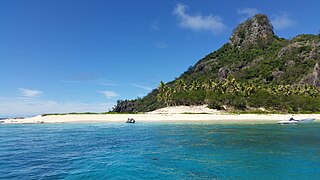
The cuisine of Nauru is the traditional cuisine of the island state on the Pacific Ocean. Due to the diversity of the country's inhabitants, the cuisine is highly diverse.
Contents
Nauru has the world's highest rate of obesity. [1]

The cuisine of Nauru is the traditional cuisine of the island state on the Pacific Ocean. Due to the diversity of the country's inhabitants, the cuisine is highly diverse.
Nauru has the world's highest rate of obesity. [1]

Like its other island neighbors, Nauruans consume a large amount of seafood, as well as foods made from coconuts and pandanus fruits. Coconut milk is also used extensively in Nauru.
The native Nauruan names of traditional crops are: [2] [3]
Nauruan cuisine is greatly influenced by Chinese cuisine. The Chinese are the major foreign community of the country, and there are a number of Chinese restaurants on the island, most notably in Yaren. In 2010, there were 138 Chinese restaurants in Nauru, [4] [ unreliable source? ] in a country of hardly 10,000 people.
Nauruan cuisine also shows strong Western influence. [5]
The majority of Nauruans are Christians, and members of the Nauru Congregational Church. They often celebrate Christmas with cakes made from banana and coconut.
Some desserts, such as coconut mousse, are consumed on special occasions.

Nauru, officially the Republic of Nauru and formerly known as Pleasant Island, is an island country and microstate in Oceania, in the Central Pacific. Its nearest neighbour is Banaba Island in Kiribati, 300 km (190 mi) to the east. It further lies northwest of Tuvalu, 1,300 km (810 mi) northeast of the Solomon Islands, east-northeast of Papua New Guinea, southeast of the Federated States of Micronesia and south of the Marshall Islands. With only a 21 km2 (8.1 sq mi) area, Nauru is the third-smallest country in the world behind Vatican City, and Monaco, making it the smallest republic. Additionally, its population of 10,670 is the world's second smallest, after Vatican City.

The history of human activity in Nauru, an island country in the Pacific Ocean, began roughly 3,000 years ago when 12 Micronesian and Polynesian clans settled the island.

The demographics of Nauru, an island country in the Pacific Ocean, are known through national censuses, which have been analysed by various statistical bureaus since the 1920s. The Nauru Bureau of Statistics have conducted this task since 1977—the first census since Nauru gained independence in 1968. The most recent census of Nauru was in 2011, when population had reached ten thousand. The population density is 478 inhabitants per square kilometre, and the overall life expectancy is 59.7 years. The population rose steadily from the 1960s until 2006 when the Government of Nauru repatriated thousands of Tuvaluan and I-Kiribati workers from the country. Since 1992, Nauru's birth rate has exceeded its death rate; the natural growth rate is positive. In terms of age structure, the population is dominated by the 15–64-year-old segment (65.6%). The median age of the population is 21.5, and the estimated gender ratio of the population is 0.91 males per one female.

Thai cuisine is the national cuisine of Thailand.

The coconut tree is a member of the palm tree family (Arecaceae) and the only living species of the genus Cocos. The term "coconut" can refer to the whole coconut palm, the seed, or the fruit, which botanically is a drupe, not a nut. The name comes from the old Portuguese and Spanish word coco, meaning 'head' or 'skull', after the three indentations on the coconut shell that resemble facial features. They are ubiquitous in coastal tropical regions and are a cultural icon of the tropics.

Nasi lemak is a dish originating in Malay cuisine that consists of fragrant rice cooked in coconut milk and pandan leaf. It is commonly found in Malaysia, where it is considered the national dish. It is also the native dish in neighbouring areas with significant Malay populations such as Singapore, Brunei, and Southern Thailand. In Indonesia it can be found in several parts of Sumatra; especially the Malay regions of Riau, Riau Islands and Medan. Nasi lemak can also be found in the Bangsamoro region of Mindanao, prepared by Filipino Moros, as well as Australia's external territories of Christmas Island and the Cocos (Keeling) Islands. It is considered one of the most famous dishes for a Malay-style breakfast.

Indonesian cuisine is a collection of various regional culinary traditions that formed the archipelagic nation of Indonesia. There are a wide variety of recipes and cuisines in part because Indonesia is composed of approximately 6,000 populated islands of the total 17,508 in the world's largest archipelago, with more than 600 ethnic groups. Many regional cuisines exist, often based upon indigenous culture with some foreign influences. Indonesia has around 5,350 traditional recipes, with 30 of them considered the most important. Indonesia's cuisine may include rice, noodle and soup dishes in modest local eateries to street-side snacks and top-dollar plates.

Latin American cuisine is the typical foods, beverages, and cooking styles common to many of the countries and cultures in Latin America. Latin America is a highly diverse area of land whose nations have varying cuisines. Some items typical of Latin American cuisine include maize-based dishes arepas, pupusas, tacos, tamales, tortillas and various salsas and other condiments. Sofrito, a culinary term that originally referred to a specific combination of sautéed or braised aromatics, exists in Latin American cuisine. It refers to a sauce of tomatoes, roasted bell peppers, garlic, onions and herbs.

The displacement of the traditional culture of Nauru by contemporary western influences is very clearly visible on the island. Only little remains preserved from the old customs. The traditions of arts and crafts are lost nearly completely.

Pandanus is a genus of monocots with some 750 accepted species. They are palm-like, dioecious trees and shrubs native to the Old World tropics and subtropics. The greatest number of species are found in Madagascar and Malesia. Common names include pandan, screw palm, and screw pine. They are classified in the order Pandanales, family Pandanaceae.

The cuisine of Hawaii incorporates five distinct styles of food, reflecting the diverse food history of settlement and immigration in the Hawaiian Islands. In the pre-contact period of Ancient Hawaii, Polynesian voyagers brought plants and animals to the Islands. As Native Hawaiians settled the area, they fished, raised taro for poi, planted coconuts, sugarcane, sweet potatoes and yams, and cooked meat and fish in earth ovens. After first contact in 1778, European and American cuisine arrived along with missionaries and whalers, who introduced their own foods and built large sugarcane plantations. Christian missionaries brought New England cuisine while whalers introduced salted fish which eventually transformed into the side dish lomilomi salmon.

Pandanus tectorius is a species of Pandanus (screwpine) that is native to Malesia, eastern Australia, and the Pacific Islands. It grows in the coastal lowlands typically near the edge of the ocean. Common names in English include thatch screwpine, Tahitian screwpine, hala tree, pandanus, and pu hala in Hawaiian. The fruit is sometimes known as hala fruit.
Lauhala, lau meaning "leaf" in the Hawaiian language, refers to the leaves of the hala tree (Pandanus tectorius).

Monuriki is a small, uninhabited island situated off the coast of Viti Levu in the Fiji Islands, in Melanesia in the South Pacific Ocean. Monuriki is part of the Atolls islands, and related to a group of three islets in the larger group of islands of known as the Mamanuca Islands. This coral and volcanic island is the smallest islet and the southernmost of a small group of three islets, west of Tavua.

The Japanese occupation of Nauru was the period of three years during which Nauru, a Pacific island under Australian administration, was occupied by the Japanese military as part of its operations in the Pacific War during World War II. With the onset of the war, the islands that flanked Japan's South Seas possessions became of vital concern to Japanese Imperial General Headquarters, and in particular to the Imperial Navy, which was tasked with protecting Japan's outlying Pacific territories.
Niue is an island in the Southern Pacific, mostly inhabited by Polynesians. The plantations are mostly filled with manioc, taro and breadfruit, but banana trees can be found. The wide range of exotic plants in Niue includes taros, pawpaw, coconuts, bananas, yams, cassavas and breadfruits: All are intensively used in the local cuisine.

The vascular plant flora of the Cocos (Keeling) Islands consists of approximately 61 species native to the 22 vegetated islands and about 69 introduced species, most of which are confined to the two larger inhabited islands, Home Island and West Island. There are no plant species endemic to the islands; however, one variety of Pandanus tectorius is only found growing on these islands. The native vegetation of the two atolls primarily consists of sea-dispersed shoreline plants of the Indo-Pacific region. On the lagoon shoreline, tall shrublands are dominated by Pemphis acidula and Cordia subcordata, often growing in monospecific stands. Closed forest stands are dominated by either Cocos nucifera or Pisonia grandis.
The cuisine of Papua New Guinea are the traditional varied foods found in the eastern part of the New Guinea island. Approximately 80% of the population is reliant on subsistence agriculture, so a large percentage of food energy and protein consumed in Papua New Guinea is produced locally, while the balance is imported. The staple foods in Papua New Guinea includes root crops, bananas, and sago. Papua New Guinea's diet is largely vegetarian, especially in the Gulf and Highlands regions.

One of the major human migration events was the maritime settlement of the islands of the Indo-Pacific by the Austronesian peoples, believed to have started from at least 5,500 to 4,000 BP. These migrations were accompanied by a set of domesticated, semi-domesticated, and commensal plants and animals transported via outrigger ships and catamarans that enabled early Austronesians to thrive in the islands of Maritime Southeast Asia, Near Oceania (Melanesia), and Remote Oceania, Madagascar, and the Comoros Islands.

Marshallese cuisine comprises the fare, foods, beverages and foodways of the Marshall Islands, including its food-related customs and traditions. Common indigenous and traditional foods include breadfruit, coconut, bananas, papaya, seafood, pandanus and bwiro. Additional imported foods, such as rice and flour, are also a part of people's diets and contribute to the cuisine as well. The practice of food preservation is a part of the history of the islands, and continues to occur today.
Two fruit trees in particular were also important: epo, the pandanus tree (Pandanus tectorius and Pandanus pulposus); and ini, the coconut palm (Cocos nucifera).
| This Nauru-related article is a stub. You can help Wikipedia by expanding it. |